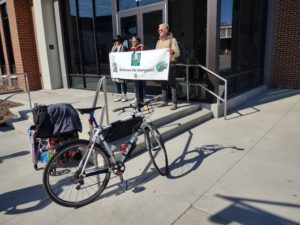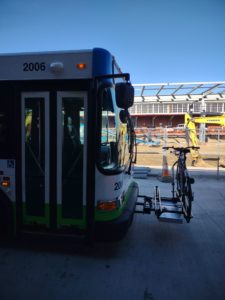Transit Equity Day is a day to promote public transit as a civil right and a strategy to combat climate change. It is held each year on February 4th to celebrate Rosa Parks’ birthday and her choice to pursue civil rights through the tactic of refusing to give up her seat on the bus. This past weekend was the first year that Transit Equity Day was celebrated in Roanoke thanks to the collaborative efforts of the Bus Riders of Roanoke Advocacy Group (BRRAG), RIDE Solutions, and Valley Metro. It also celebrated BRRAG’s one-year anniversary as an organization. It was also the first time that I rode the bus in Roanoke.
This post is to talk a bit about transit in Roanoke and my one-day experience riding the bus. When I was growing up in Seattle and living in DC, it was pretty common for me to ride transit because distances were too far or weather too rainy for biking. Sometimes I would take transit to a place and ride back, or ride to a place and take transit back. In my experience, transit and biking go very well together – and there’s no reason that shouldn’t be the case in Roanoke.

The Transit Equity Day event was great. It had several speakers, including Bernadette “BJ” Lark, Dr. Laura Hartman, Vice Mayor Joe Cobb, and Valley Metro General Manager Kevin Price. Speeches focused on the value of transit to the community today and throughout history. Several speakers talked about transit – and transportation – as a civil right that allows full participation in our community to people who lack vehicles, are unable to operate vehicles, or otherwise would be excluded due to mobility issues.
A highlight was learning about Margie Jumper who refused to give up her seat in a segregated trolley in Roanoke in 1946. While her protest did not immediately prompt action, she was a dedicated civil rights activist in Roanoke for decades. Roanoke’s transit system was not desegregated until 1963 – 17 years later. For several years the Commonwealth Coach and Trolley Museum had a bus in service at the time of desegregation with a dedicated seat to honor her. Unfortunately, that bus was burned in a fire that devastated the museum in 2017.
After the speaker part of the event wrapped up most people headed inside the new 3rd Street Transit Center downtown. It’s a nice building, but still under construction. I quickly learned that no bike parking currently exists at the station, so hopefully that will come as it is completed. Bikes are also not allowed inside, so I ended up standing outside talking to people until the buses showed up. All Valley Metro buses arrive and depart at roughly the same time, once every hour or half hour, depending upon route and time of day. On Transit Equity Day fares were free, so I figured I would ride the bus and bike back home.
I loaded my bike on the front of the #11 bus, which goes from downtown through northwest Roanoke to Valley View Mall. The bike rack on the front of the bus was very easy to use. It was a Sportworks rack, probably their DL2 model. Sportworks was founded near where I grew up in Redmond, Washington and is recognized as a Gold Level Bicycle Friendly Business by the League Of American Bicyclists. To use the rack, I simply grabbed a handle at the top, squeezed to release the rack down, placed my bike in the rack much like I would on my car’s hitch rack, and secured the front wheel with a sturdy and grippy support arm. Valley Metro has some advice for using the rack on their website too.
The #11 bus was packed for my ride. According to Valley Metro data, the #11 bus was the sixth most popular route in 2017. People were standing in the aisle as all rows and most seats were taken. It seemed like the area around Hershberger and Cove Road and the area around Valley View Mall, especially Walmart, were the most popular places for people to get on and off.
The bus seemed newly refurbished inside. There were two digital displays that showed upcoming stops and one dot matrix display that had a more traditional scroll of bus route information. A highlight for me was the four camera feeds on another display that allowed me to easily watch my bike from my seat towards the back of the bus. This was a great comfort as I could watch to see if my bike became loose (it didn’t) or if anyone approached my bike (no one did). As a person who is very protective of my bike(s), it was great for my peace of mind to have such a great view from anywhere in the bus.
I got off at Walmart and then biked back home along Williamson to get a better sense of the road that I have written about several times. No surprise, it was uncomfortable to bike on. I also noticed several people waiting at transit stops along the way in places that almost uniformly lacked places to sit, shade, or any covering from the elements. According to the Virginia Department of Transportation, no bus stops on Williamson are fully compliant with the Americans with Disabilities Act.
My experience with Transit Equity Day in Roanoke showed me that there is a strong community of transit riders advocating for improvements. Valley Metro has a plan to make improvements and in BRRAG there is now a strong voice for riders to inform those improvements and advocate for them. The bus system in Roanoke has pretty obvious limitations due to its infrequency, its reliance on a central transfer point, inconsistent biking and walking infrastructure throughout the city, a lack of bike racks at transit centers and stops, and a lack of facilities at stops. But, there’s some energy to change that and I hope to see it change.


